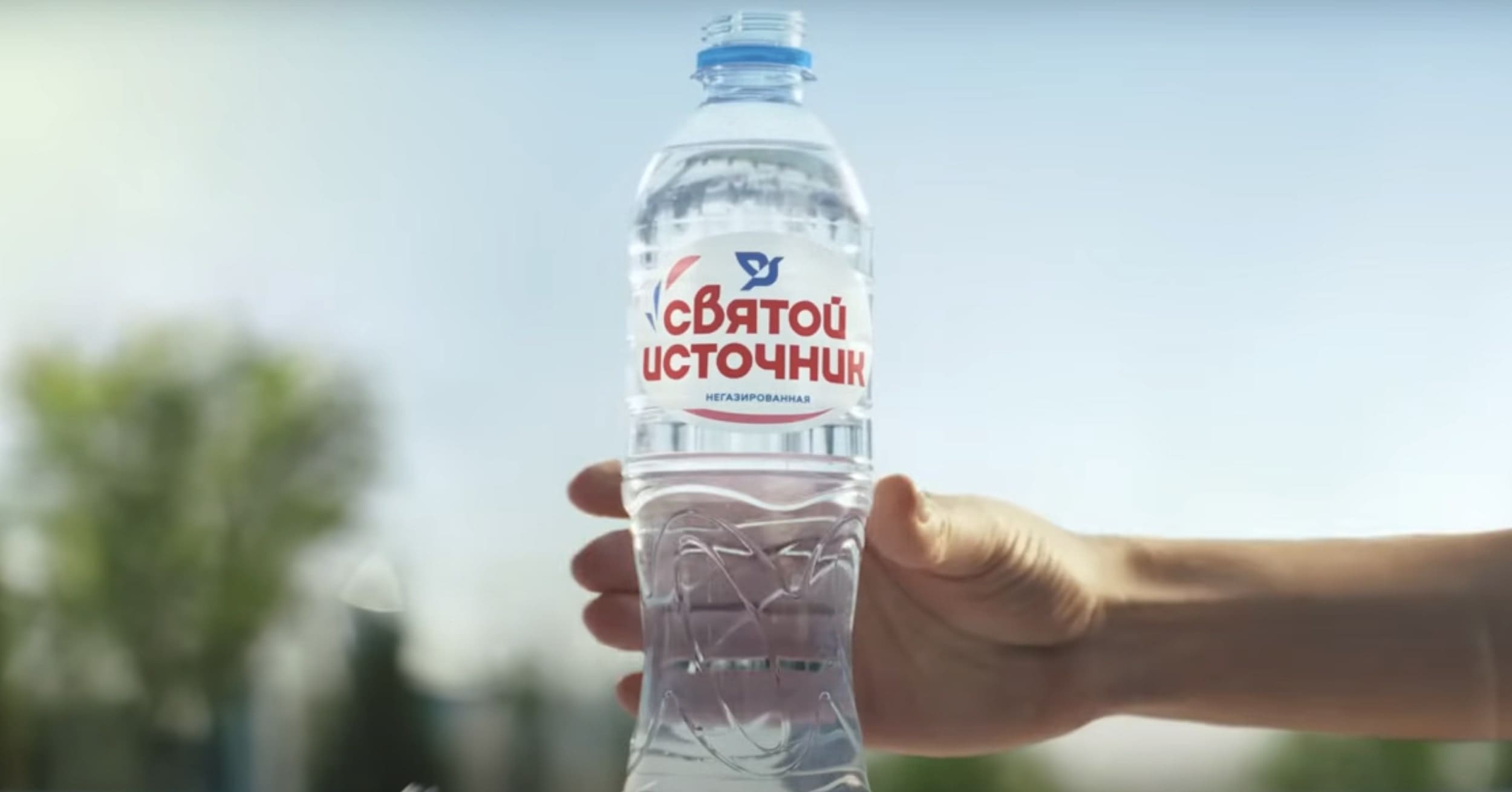In July 2024, Russian users of social networks and messengers began to warn friends and colleagues: Ukrainian saboteurs had sent at least one batch of poisoned bottled water to the Russian Federation, which was sold under the “Holy Source” brand. At the request of “Checked,” social anthropologist Alexandra Arkhipova figured out how this frightening news appeared and spread.
The first reports of poisoned water from the Holy Spring appeared in the Russian-language segment of the Internet on July 10. The most common warnings were in the form of a voice message from an unknown woman:
“Girls, hello everyone! Look, my cousin just called. Her brother, well, that is, my cousin, basically serves in intelligence in Ukraine. I called and warned her: a huge batch of poisoned “Holy Spring” mineral water had leaked into Russia. I warned her - to warn everyone who is possible: do not buy “Holy Spring” water for now. They are looking for her, tracking where she went to which networks or base. Just in case, warn all your people there who... that’s the “Holy Spring.”
This is often followed by the caption “The director threw it off” and a short audio in which a man gives orders in a commanding voice:
“Distribute to all groups! This is not fake, this is a real thing, a real incident. Among our friends it is confirmed that yes, there are deaths, and there are already fifteen people.”
Some messages were more succinct.
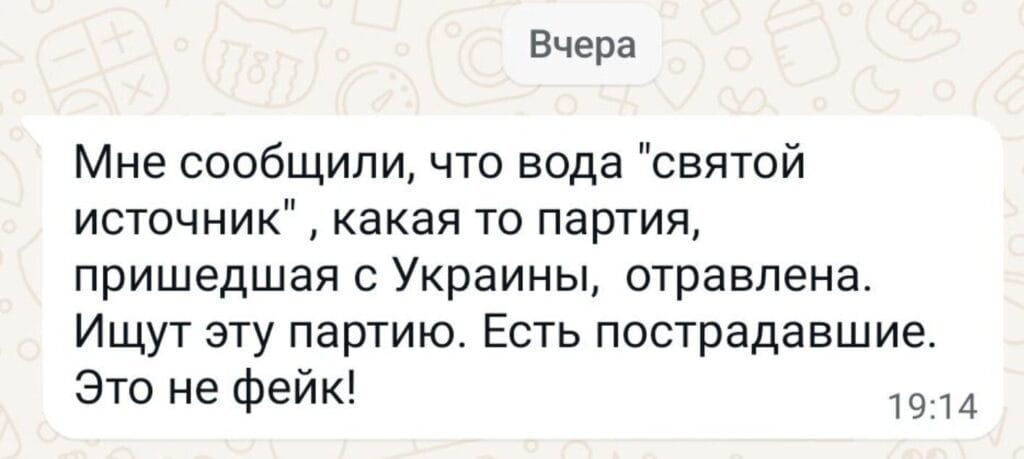
Such warnings were distributed via WhatsApp, X, YouTube and other platforms.
At the same time, neither reputable media nor government agencies reported cases of poisoning with the “Holy Spring” or other bottled water. The contrast is especially noticeable given the way the recent botulism outbreak in Russia - then more than 400 people were hospitalized in different regions after eating dishes with beans prepared by the "Kitchen on the District" company.
Bottle panic
Concern over poisoned water has arisen in many regions of Russia - from Rostov-on-Don to Sakhalin. July 16 edition of “Notepad. Stavropol" interviewed their readers, whether they saw warning posts on social networks or heard something similar from friends. More than 78% of respondents responded that they were familiar with these messages.
According to the Yandex.Wordstat service, Russian Internet users were actively finding out the details of the story about poisoned water that had spread across the Internet. From July 10 to July 19, they sent the search query “Holy spring poisoned” to Yandex more than 62,000 times, “poisoned water, holy spring” more than 52,000 times, and “holy spring poisoned by Ukraine” more than 8,000 times. About 10,000 more times, users studied search results for less popular queries on the same topic. Moreover, the share of requests about the “Holy Source” brand itself also increased, and simultaneously with the mention of “poisoned water.” This likely means that when users simply asked about this brand of water, they were primarily interested in the likelihood of poisoning.
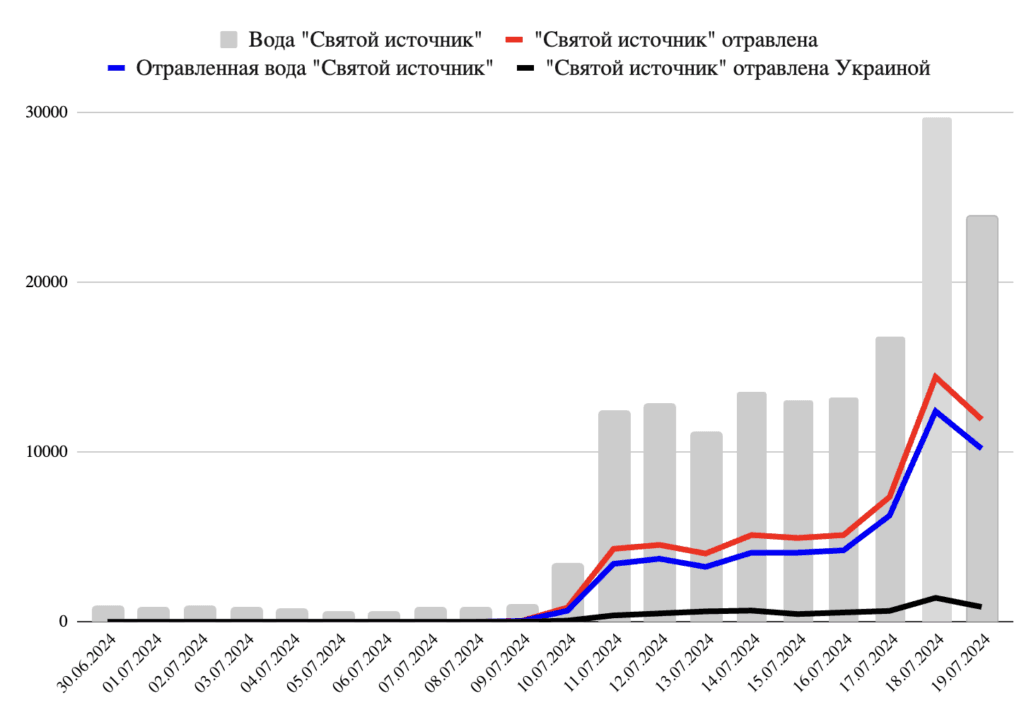
This number of requests is an indirect argument in favor of the fact that panic is truly massive. For comparison, in July, Russian social media users also spread a rumor about cholera in water bodies (more on that below), but hundreds, not tens of thousands, of users sent relevant requests to Yandex.
Mirror fake
All these warnings about the poisoned water “Holy Spring” in Russian social networks and chats are a mirror reflection of a similar panic that has gripped the Ukrainian segment of the Internet.
On July 10 at 17:26 Moscow time, Ukrainian military Stanislav Bunyatov (call sign Osman) in his popular (more than 220,000 subscribers) Telegram channel “Speaking Sniper” wrotethat Russian troops, leaving their positions, deliberately leave poisoned water there. “They don’t drink themselves, they gave a prisoner [Russian] something to drink, but he refused,” notes Bunyatov. The post is accompanied by a photograph of several bottles of “Holy Spring,” although the Ukrainian military does not mention this brand in the text. How Bunyatov found out that the water was poisoned is unknown - in a comment to the Ukrainian publication Focus a couple of hours later, he admitted, that still “doesn’t know if anyone did tests on that water.”
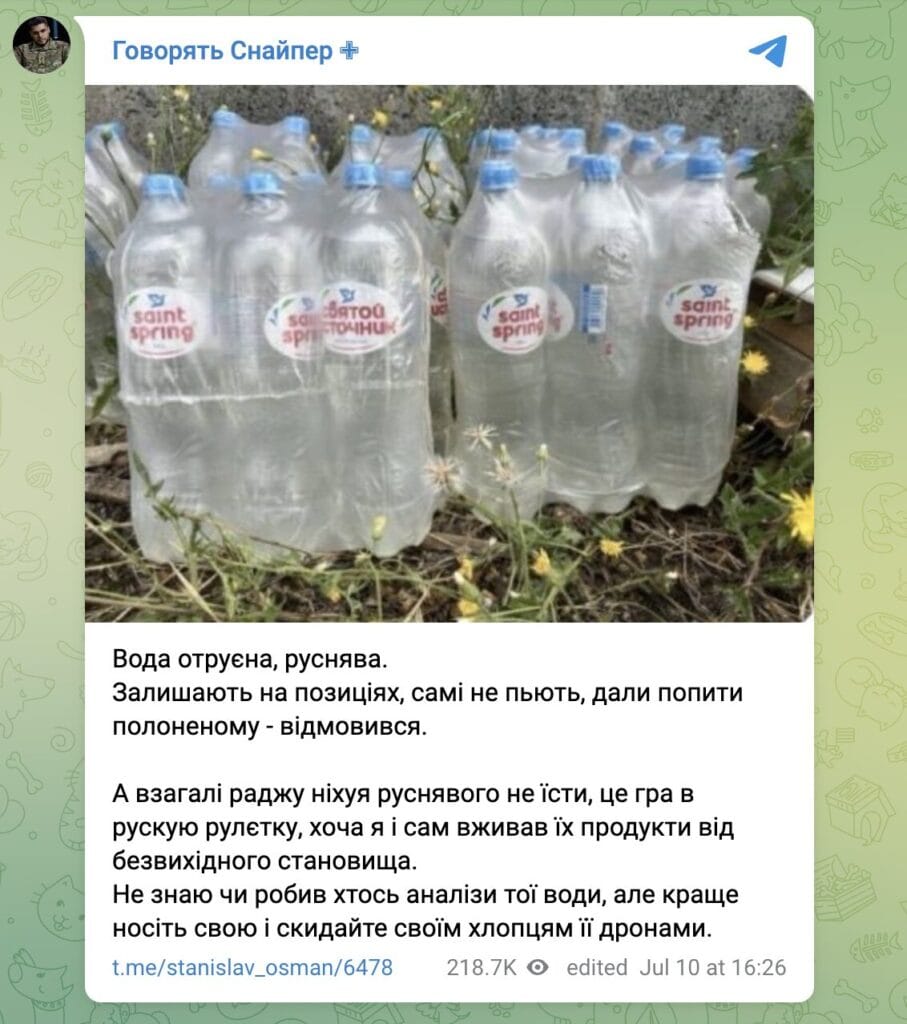
On the morning of July 13, the channel “Northern Wind” (32,000 views at the time of writing this analysis), which, according to the description, is run by representatives of the Russian group of forces “North”, also appeared a post about poisoned water, but the “Holy Source” brand was not mentioned in it. In publication it says (hereinafter in quotations the author’s spelling and punctuation are preserved):
“According to the prisoners, Ukrainian saboteurs intended to use UAVs to drop bottles of poisoned water on the positions of Russian troops. However, due to the abnormal heat, some Ukrainian “superminds” who were unaware of the operation decided to steal several packages of such water to their unit. As a result, an entire company of the Ukrainian Armed Forces was put out of action and moved to more advantageous positions in the toilet.”
Soon the failure of the supposed SBU operation with reference to prisoners was reported, for example, by the channels “Sheikh Tamir"(134,000 views), "Sladkov + 1" (41,000) and "Partisans"(31,000). And the channel “Ukropsky Fresh” (4800 views) claimed:
“We assume that this is only the official version, in which the militants were convinced by the SBU. In fact, the Ukrainian Armed Forces have great difficulties with water... so now the militants drink only bottled water. But the Ministry of Defense cannot (or does not want to) arrange water supplies, so the teams have to take water from volunteers, and from everyone who offers, there is no choice.
And then partisans appear who deliberately supply the troops with water that is unsuitable for drinking - there are many known cases of deliberate actions by partisans with poisoning of the Armed Forces of Ukraine. <…> So we assume that this is exactly what happened: the partisans supplied poisoned water to the militants, and the SBU tried to prevent panic among the troops and spread a rumor that the SBU itself had deliberately poisoned this water in order to dump it on Russian positions.”
“Ukropsky Fresh” gave examples of “deliberate actions of partisans,” citing its own posts from July 20, 2023 And February 2, 2024 (the latter also reposted channel "Ukraina.ru" - 114,000 views). They stated that in the Sumy region they were looking for, and in the Kharkov region they had already detained saboteurs who were poisoning drinking water for the Ukrainian Armed Forces fighters. In the first case, evidence is provided of a photograph of a certain SBU document on the inspection of agricultural enterprises and a screenshot of correspondence, one of the participants in which reports that “forty military personnel lost two hundred from poisoning” (water is not mentioned). In the second case, Ukropsky Fresh illustrated its statements with photographs taken from press release The Kharkov Regional Prosecutor's Office has charged two residents of the region with suspicion of illegal production of alcoholic beverages. The pro-Kremlin Telegram channel operated according to its usual pattern - as before wrote “Verified”, many of his posts are distorted reports from Ukrainian law enforcement agencies.
At the same time, the horror story about the water poisoned by the Russians continued to spread among the residents of Ukraine. On the night of July 16, Kyiv blogger Anton Gura posted in his Telegram channel (113,000 views) a screenshot of messages sent by a certain “commander” named Vladimir. One of them was the same photograph of the Holy Spring packaging that Bunyatov had previously published. “The guys from the front sent us. They ask you to convey information to other guys, if you see such water, do not drink,” Gura himself commented on the screenshot.
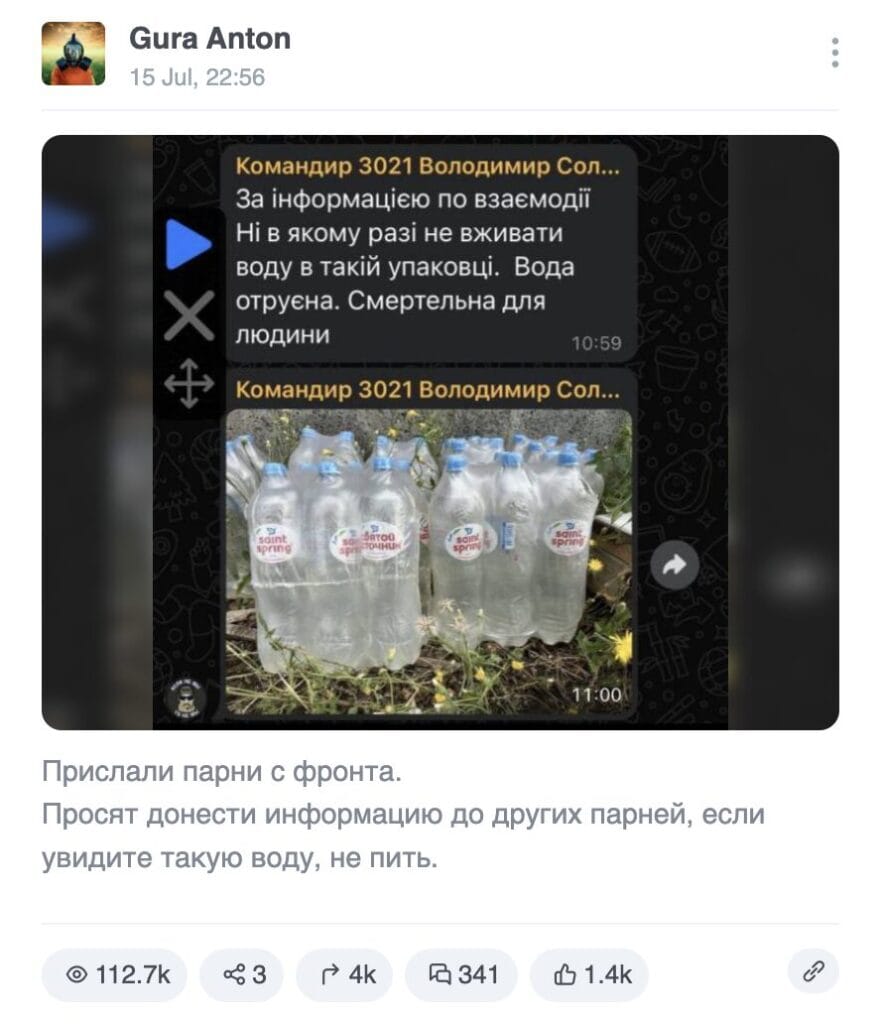
The next morning the same screenshot with a link to the blogger published and “Fresh Dill”. In his presentation, poisoned water from the “Holy Spring” is allegedly supplied to units of the Ukrainian Armed Forces. Although Gura did not write anything about the supplies, the pro-Kremlin channel saw in his post proof of its assumption about the successful work of the partisans in the Ukrainian rear. The fact that the “Holy Source” brand is not represented in Ukraine, and the company’s factories located in Russia, the authors of “Ukropsky Fresh” were not embarrassed.
Warnings that circulated in the Russian segment of social networks about the poisoning of an entire batch of “Holy Spring” water, intended not for the military, but for civilians in the Russian Federation, began to appear shortly after Bunyatov’s original post on July 10. This is evidenced by both Yandex.Wordstat statistics and the time of the first refutations. Moscow-controlled media operating in the occupied territories of Ukraine began publishing them no later than July 13. That day on the website “Moskovsky Komsomolets - Zaporozhye” came out a note entitled “The enemy has spread misinformation about the poisoning of drinking water in the Zaporozhye region.” The author did not provide any arguments to refute the panic messages, but noted in the publication:
“The information strike was delivered competently and at the right time from the point of view of information impact. The authorities in the region are struggling with disinformation, but the goal of such fake news is not even to make people believe in something, but to intensify negative emotions. This is more difficult to deal with.
However, information war is a tango that takes two.”
Other fears about poisoned water
Bunyatov’s post appeared shortly after another similar warning circulated in Ukraine. On the night of July 9, volunteer Ekaterina Terekhova, who, along with dozens of other Kiev residents, helped clear the rubble of one of the buildings of the Okhmatdyt children's hospital, destroyed as a result of Russian shelling, told on Instagram that she was a victim of poisoning:
“Today, as you know, a lot of people from Kyiv brought a lot of water to Okhmatdyt... The police came up. We said that we were leaving water for them and continued to pack. Within a minute the police called us and said: “What kind of water do you have?” You can see my face now. It's red. We all have chemical poisoning. <…> They simply poisoned the water bottles.”
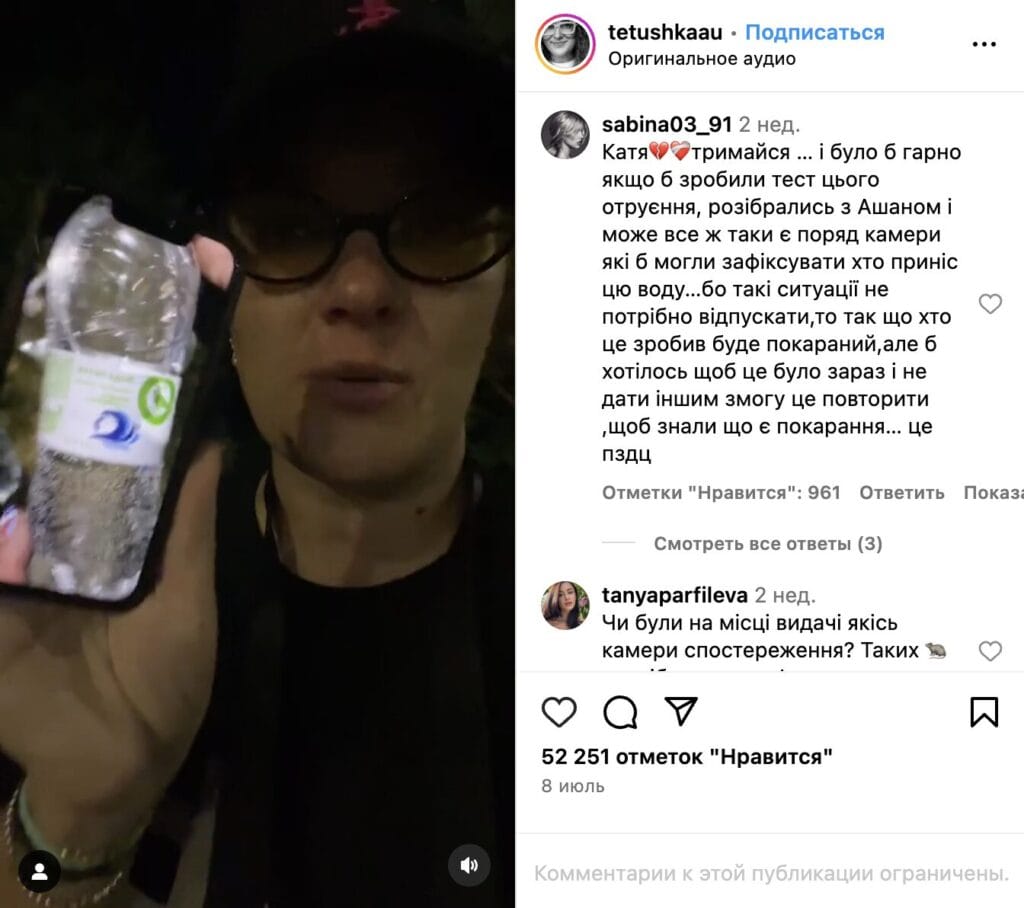
In the video, Terekhova noted that she and several other people who drank that water were given injections, and one of the policemen was being pumped out. Panic began - video of a volunteer published large Ukrainian Telegram channels. July 9 Kyiv police reported, which is checking the information spread on social networks about the poisoning of drinking water among people who were in the Okhmatdyt area the day before. “At the same time, we inform you that medical staff have not received any complaints from citizens or police regarding water poisoning,” the press release emphasizes.
The spread of the mirror version of the fake in the Russian Federation also occurs against the backdrop of constant expectations that something wrong will happen to the water. In Russian and Belarusian chats already third summer in a row a rumor is spreading that cholera. According to the authors of the newsletters, it was brought there by Ukrainian saboteurs.

In hot weather, when consumption of drinking (and especially bottled) water naturally increases, and in some regions in the south of Russia And in the occupied Ukrainian territories There are interruptions in the water supply, and rumors about poisoned water are spreading very actively.
They are also fueled by reports from the Federal Security Service of the Russian Federation about the disclosure of the most phantasmagoric sabotage. Thus, in September 2023, the press service of the Russian FSB Directorate for the Altai Territory reportedthat a 42-year-old local resident was arrested in Barnaul - he allegedly poisoned the water intended for local conscripts. According to the intelligence service, the detainee did this as evidence of his intentions to cooperate with representatives of Ukraine.
Where do such fears come from?
In a situation of social catastrophe, one of the most popular and fastest myths is the legend of well water poisoners. A pest, a representative of an alien ethnic (Jews) or social (for example, doctors) group, who infects with dangerous diseases, is a frequent character in the chronicles of the 14th century. At that time, when epidemics spread in European cities, Jews were often accused of poisoning rivers and wells. Although met and more exotic accusations: for example, one chronicle says that the Jews wanted to poison all Christians by mixing frogs and spiders into cheese.
Similar accusations didn't stop sound in the 19th century. During the Patriotic War of 1812, Russian peasants suspected the French of poisoning water bodies; at the height of the cholera epidemic of 1830–1831, the Poles, who at the same time revolted, during the First World War - German Jewish spies. In 1950–1953, during the anti-Semitic campaign in the USSR, there were rumors that Jews were contaminating the water in schools with tuberculosis.
Why did a similar myth become popular in 2024? In a situation of war and social catastrophe, the picture of the world of many people tends to be binary and becomes black and white. This “simplification” does not arise just like that: it is a consequence of social evolution. To survive in a situation of conflict, the brain must very quickly divide the world into friends and foes, without any halftones or doubts. In the language of a behavioral economist Daniel Kahneman, the system of making quick decisions comes into play. It is precisely based on stereotypes and myths, because it is precisely such terrible stories that not only make it possible to understand who the enemy is, but also why this enemy must be fought - because this enemy is capable of committing absolute evil, such as massive contamination of water. Therefore, at the front and beyond, in a situation of fear, not only real stories about war crimes are spread, but also unsubstantiated horror stories.
***
The poisoning of Holy Spring bottled water is not just fake news, it is an inversion of fake news. Apparently, it arose as a result of a mirror reversal of the Ukrainian front-line rumor that the Russian military was poisoning water produced under a well-known brand in the Russian Federation. At the same time, the core of the rumor was preserved, only the “villains” changed - instead of the Russian military, they became Ukrainian saboteurs.
Over the past two weeks, Russian federal and regional media have regularly published articles refuting the fake news about the poisoned water “Holy Spring”. Appeared it is also on the TASS agency website in the thematic section “Verified by TASS”.
But all these denials, judging by Yandex.Wordstat data, did not stop the wave of panic messages and requests. This is probably due, among other things, to the weak evidence base. For example, TASS, in its analysis, emphasizes that all products are labeled to guarantee quality, plastic bottles are sealed, and anyone can verify the safety of the contents by taking a virtual tour of the manufacturing plant. Some other publications simply routinely blame TsIPsO for everything - Center for Information and Psychological Operations as part of the Special Operations Forces of the Armed Forces of Ukraine, the result of which many Russian propaganda resources call almost any publication on the Internet that contradicts their own view of the world.
For people who live in a situation of permanent social catastrophe, it is not so important who exactly poisoned the water. In anticipation of the next misfortune, the desire to warn one’s own about a possible danger is much more significant, and rumors concerning everyday life and things close to the body receive priority in spreading.
Cover photo: YouTube screenshot
- A. Arkhipova, A. Kirzyuk. Dangerous Soviet things: urban legends and fears in the USSR
- A. Arkhipova and others. Fake or true? How people spread and verify rumors online
- Is the newsletter true about Palestinian vipers being delivered to the Moscow region by drones from Ukraine?
- Is it true that saboteurs are scattering explosives near Russian schools?
If you find a spelling or grammatical error, please let us know by highlighting the error text and clicking Ctrl+Enter.


